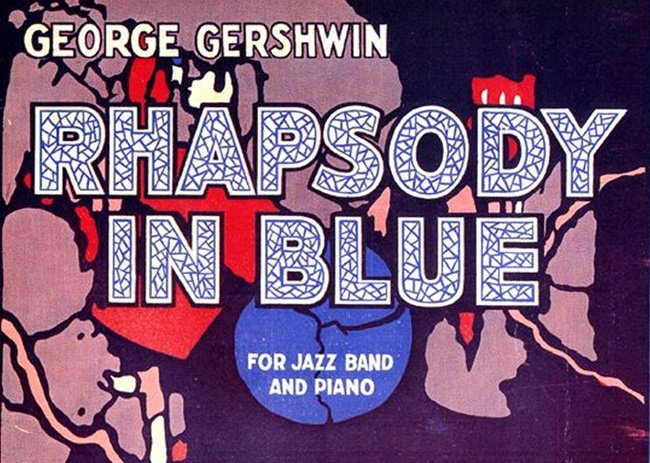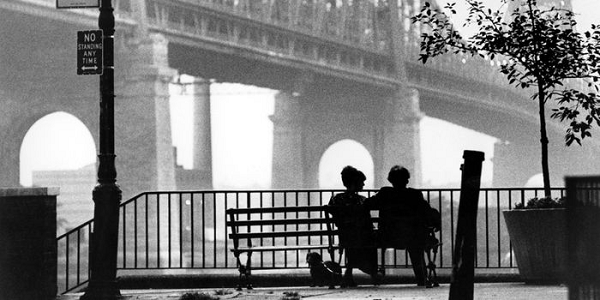George Gershwin, Woody Allen y "Rhapsody in Blue" (Esp | Eng)
Los que configuramos lo fundamental de nuestra "educación sentimental" (usando la frase de Flaubert) entre la década del 70 y parte de la siguiente, tuvimos como referencias vitales el rock de los Rolling Stones, el folk de Bob Dylan, el blues de B. B. King y Eric Clapton, el jazz de Louis Armstrong y Ella Fitzgerald, entre las capitales. En literatura a la Generación Beat y a Julio Cortázar, entre otros. Y en cine nos cautivó el humor irónico y poético de Woody Allen, un ejemplo principal.
Había escuchado al George Gershwin de Rhapsody in Blue, pero no con la atención debida ni la fruición que se merece. La redescubriría gracias a esa suerte de duende del cine estadounidense: Woody Allen, que en 1979 nos regaló esa maravilla fílmica que es Manhattan. A esas dos figuras y a esas dos amadas obras quiero dedicar este post.

Nacido en Brooklyn el 26 de septiembre de 1898, George Gershwin, hijo de inmigrantes ucranianos de origen judío, fue el músico y compositor que introduciría en el campo cultural estadounidense, y posteriormente europeo, la confluencia de la música llamada clásica o culta por algunos y la música de raíces populares, como lo son el blues y el jazz. Siendo un autodidacta, llegó a ser un pianista muy reconocido y respetado por compositores de la talla de Maurice Ravel e Igor Stravinsky, que alcanzó gran éxito en vida.
Ya a la edad de 26 años, en 1924, creó la composición que le dará mayor fama internacional: Rhapsody in Blue, obra para piano y orquesta, en la que se reúnen las claves de lo que será, en lo fundamental, su aporte a la música moderna universal. En ella logró conjugar Gershwin, genialmente, la música de estilo clásico con lo jazzístico, en una magistral combinación de lo orquestal con la intervención solista.
En la interpretación de 1976 de la Orquesta Filarmónica de Nueva York, bajo la dirección de Leonard Bernstein, quien ejecuta el piano, se puede apreciar lo magistral de la orquestación, pero también lo lúdico de las intervenciones del piano y otros instrumentos, en un guiño al jazz y al blues. Todo es una fastuosa y muy expresiva pieza en homenaje a Nueva York, en la que creció Gershwin.
Ese tributo extraordinario e inmortal a su ciudad, será recogido por el genial cineasta estadounidense, Woody Allen, nacido también en Nueva York, para mostrarnos su amorosa relación contradictoria con ella, en un filme que ha pasado a la historia del cine como una suerte de poema sinfónico audiovisual para el corazón de la "Gran Manzana": Manhattan.
En Manhattan, realizada en 1979, Allen (quien protagoniza como actor) nos presenta su pasión —amor y padecimiento— por esta parte raigal de su vida, así como lo hace con el personaje escritor y sus contradictorias relaciones amorosas.

Tal como se puede apreciar en el fragmento del filme que reproduzco, los primeros cuatro minutos del filme de Woody Allen son un elogio poético y realista (o viceversa) a ese espacio vital, que nos reaviva la significación de Rhapsody in Blue mediante un maravilloso juego de fotos fijas en blanco y negro (no podría ser de otro modo) de la ciudad.
Como escuchas y espectadores, asistimos a estas dos grandes expresiones del arte, que siempre estarán en nuestra gratitud y afecto.
![Click here to read in english]
George Gershwin, Woody Allen and "Rhapsody in Blue"
Those of us who shaped our "sentimental education" (using Flaubert's phrase) between the 70s and part of the following decade had as vital reference the rock of the Rolling Stones, the folk of Bob Dylan, the blues of B. B. King and Eric Clapton, the jazz of Louis Armstrong and Ella Fitzgerald. In literature, the Beat Generation and Julio Cortázar, among others. And in cinema, we were captivated by the ironic and poetic humor of Woody Allen, a prime example.
I had heard George Gershwin's Rhapsody in Blue, but not with the due attention or the enjoyment it deserves. I would rediscover it thanks to that kind of elf of American cinema: Woody Allen, who in 1979 gave us that cinematic marvel that is Manhattan. I want to dedicate this post to those two figures and those two beloved works.
Born in Brooklyn on September 26, 1898, George Gershwin, the son of Ukrainian immigrants of Jewish origin, was the musician and composer who would introduce into the American, and later European, cultural field the confluence of music called classical or cultured by some and music with popular roots, such as blues and jazz. Being self-taught, he became a highly recognized and respected pianist by composers such as Maurice Ravel and Igor Stravinsky, who achieved great success during his lifetime. Already at the age of 26, in 1924, he created the composition that would bring him the greatest international fame: Rhapsody in Blue, a work for piano and orchestra, which brings together the keys to what would be, fundamentally, his contribution to universal modern music. In it, Gershwin brilliantly managed to combine classical music with jazz, in a masterful combination of the orchestral and the solo intervention.
In the 1976 performance by the New York Philharmonic Orchestra, under the direction of Leonard Bernstein, who plays the piano, one can appreciate the mastery of the orchestration, but also the playfulness of the interventions of the piano and other instruments, in a nod to jazz and blues. It is all a lavish and very expressive piece in homage to New York, where Gershwin grew up. This extraordinary and immortal tribute to his city will be taken up by the brilliant American filmmaker, Woody Allen, born in New York, to show us his loving and contradictory relationship with it, in a film that has gone down in the history of cinema as a sort of audiovisual symphonic poem for the heart of the "Big Apple": Manhattan.
In Manhattan, made in 1979, Allen (who stars as an actor) presents us with his passion – love and suffering – for this fundamental part of his life, as he does with the writer character and his contradictory love relationships.
As can be seen in the fragment of the film that I reproduce, the first four minutes of Woody Allen's film are a poetic and realistic praise (or vice versa) to that vital space, which revives the meaning of Rhapsody in Blue through a wonderful game of black and white still photos (it could not be otherwise) of the city. As listeners and spectators, we witness these two great expressions of art, which will always be in our gratitude and affection.





